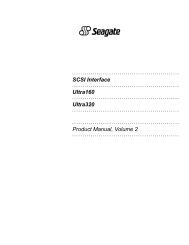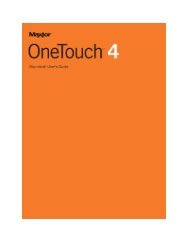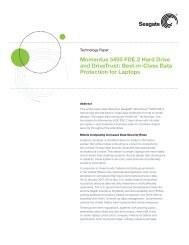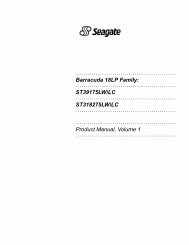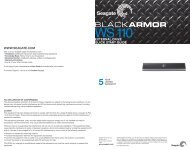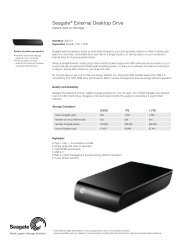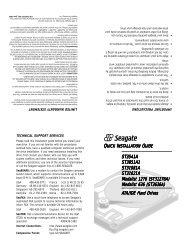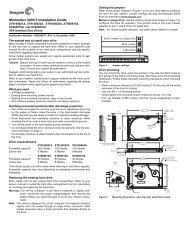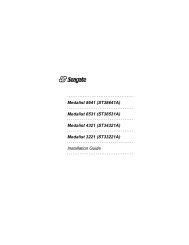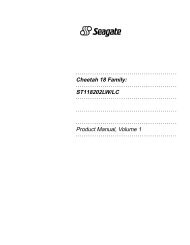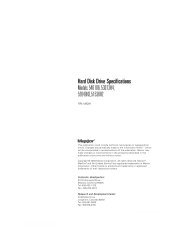Quickview 300 Product Manual PATA - Seagate
Quickview 300 Product Manual PATA - Seagate
Quickview 300 Product Manual PATA - Seagate
Create successful ePaper yourself
Turn your PDF publications into a flip-book with our unique Google optimized e-Paper software.
Breaking the 137GB Storage Barrier<br />
A.1.2<br />
Solving the 137 Gigabyte Capacity Barrier<br />
As described earlier, the issue causing the 137-gigabyte barrier is the 28-<br />
bit addressing method of the original ATA specification. A change to<br />
expand this method was required to provide more address bits for the<br />
interface, allowing significant growth for many years to come. A critical<br />
issue in expanding the addressing capability was maintaining<br />
compatibility with the existing installed base of products.<br />
The new ATA standard, ATA/ATAPI-6, resolves this issue by increasing<br />
the maximum number of bits used for addressing from 28 to 48. This<br />
solution increases the maximum capacity of an ATA device to 144<br />
petabytes while maintaining compatibility with current ATA products.<br />
A.1.3<br />
How is the Extension Implemented?<br />
The 48-bit Address feature set provides a method to address devices with<br />
capacities up to approximately 144 petabytes by increasing the number<br />
of bits used to specify logical block addresses (LBAs) from 28 to 48. The<br />
feature set also provides a method to increase the number of sectors that<br />
can be transferred by a single command from 256 to 65,536 by<br />
increasing the number of bits specifying sector count to 16 bits.<br />
New commands specific to this feature set have been defined so that<br />
devices can implement the new feature set in addition to previously<br />
defined commands. Devices implementing the 48-bit Address feature set<br />
commands will also implement commands that use 28-bit addressing in<br />
order to maintain interoperability with older system components. In<br />
addition, 8-bit and 48-bit commands may be intermixed.<br />
The 48-bit Address feature set operates in LBA addressing only. Support<br />
of the 48-bit Address feature set is indicated in the IDENTIFY DEVICE<br />
response data. In a device implementing the 48-bit Address feature set,<br />
the registers used for addressing are, in fact, a two-byte deep FIFO. Each<br />
time one of these registers is written, the new content written is placed<br />
into the “most recently written” location and the previous content of the<br />
register is moved to “previous content” location. A host may read the<br />
“previous content” of the registers by first setting a bit in the Device<br />
Control register to 1 and then reading the desired register.<br />
A.1.4<br />
What Do the Drives Need to Meet the Spec?<br />
The challenge to drive manufacturers is to develop and implement new<br />
interface chips on drives that can accept and decode the new 48-bit<br />
addressing scheme. Many functions of decoding the commands sent to<br />
and from the drive are automated in the silicon of the drive interface<br />
ASIC, and this is where drive manufacturers must update their designs.<br />
Maxtor is the leader in development efforts and is the first to deliver a<br />
product with the capacity and drive technology to deliver greater than<br />
137 gigabytes of capacity.<br />
<strong>Quickview</strong> <strong>300</strong> 80/100/120/160/200/250/<strong>300</strong>GB <strong>PATA</strong> A-3



